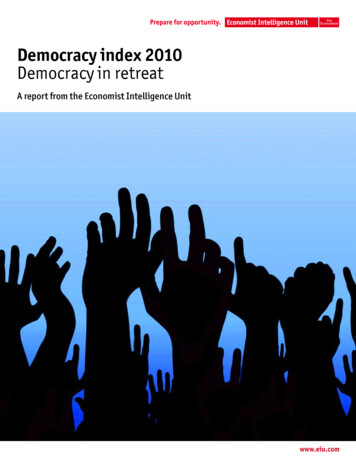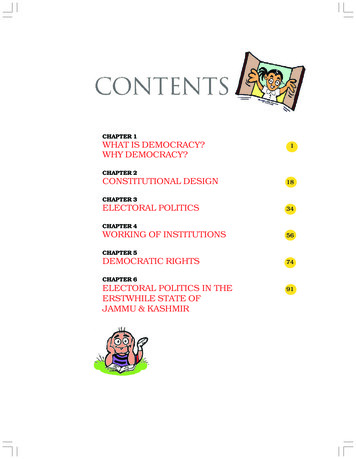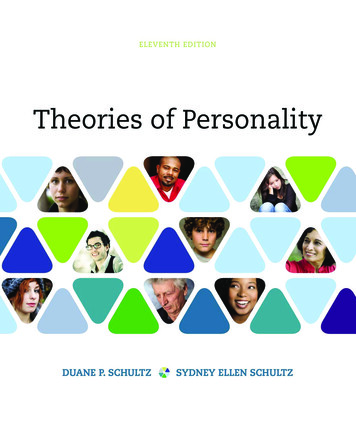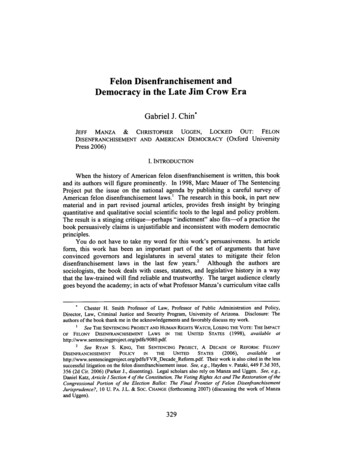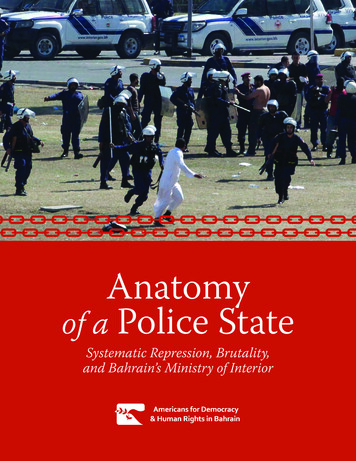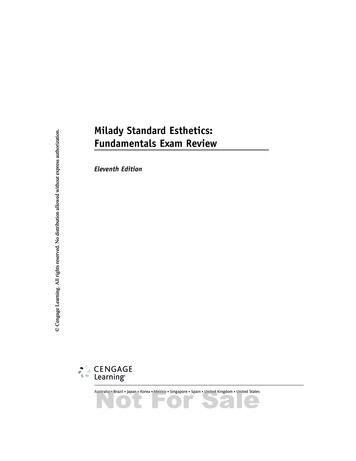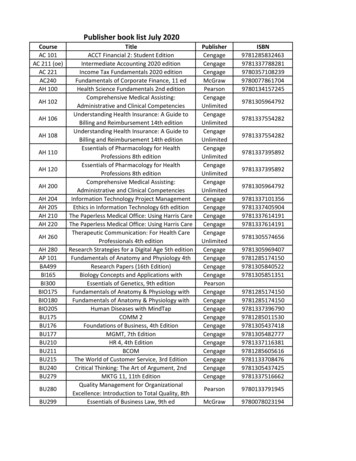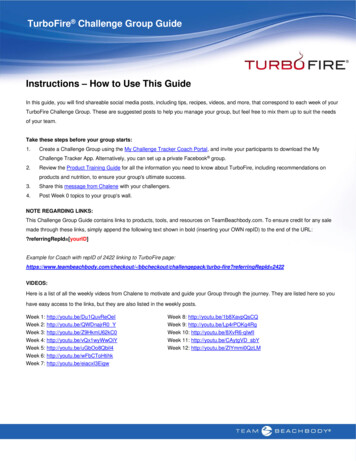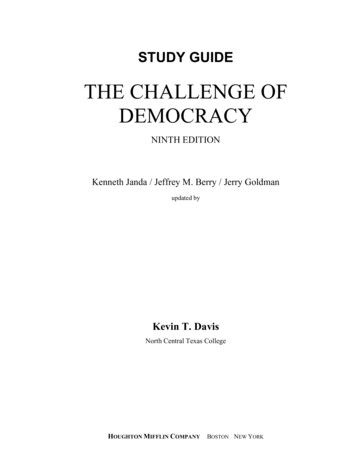
Transcription
STUDY GUIDETHE CHALLENGE OFDEMOCRACYNINTH EDITIONKenneth Janda / Jeffrey M. Berry / Jerry Goldmanupdated byKevin T. DavisNorth Central Texas CollegeHOUGHTON MIFFLIN COMPANY BOSTON NEW YORK
Publisher: Suzanne JeansSenior Sponsoring Editor: Traci MuellerDevelopment Editor: Lisa Kalner WilliamsEditorial Assistant: Tiffany HillExecutive Marketing Manager: Nicola PoserMarketing Associate: Karen MulveyCopyright 2008 by Houghton Mifflin Company. All rights reserved.No part of this work may be reproduced or transmitted in any form or by any means, electronic ormechanical, including photocopying and recording, or by any information storage or retrieval systemwithout the prior written permission of Houghton Mifflin Company unless such copying is expresslypermitted by federal copyright law. Address inquiries to College Permissions, Houghton MifflinCompany, 222 Berkeley Street, Boston, MA 02116-3764.Printed in the U.S.A.ISBN 10: 0-618-87449-6ISBN 13: 978-0-618-87449-1123456789-XX-10 09 08 07 06
ContentsPREFACE. VCHAPTER 1 – FREEDOM, ORDER, OR EQUALITY?. 1CHAPTER 2 – MAJORITARIAN OR PLURALIST DEMOCRACY? . 13CHAPTER 3 – THE CONSTITUTION . 22CHAPTER 4 – FEDERALISM . 33CHAPTER 5 – PUBLIC OPINION AND POLITICAL SOCIALIZATION . 43CHAPTER 6 – THE MASS MEDIA . 52CHAPTER 7 – PARTICIPATION AND VOTING . 64CHAPTER 8 – POLITICAL PARTIES . 74CHAPTER 9 – NOMINATIONS, CAMPAIGNS, AND ELECTIONS . 83CHAPTER 10 – INTEREST GROUPS . 92CHAPTER 11 – CONGRESS . 102CHAPTER 12 – THE PRESIDENCY . 113CHAPTER 13 – THE BUREAUCRACY . 122CHAPTER 14 – THE COURTS . 132CHAPTER 15 – ORDER AND CIVIL LIBERTIES . 143CHAPTER 16 – EQUALITY AND CIVIL RIGHTS . 154CHAPTER 17 – POLICYMAKING. 165CHAPTER 18 – ECONOMIC POLICY . 174CHAPTER 19 – DOMESTIC POLICY . 184CHAPTER 20 – GLOBAL POLICY . 194Copyright Houghton Mifflin Company. All rights reserved.
PrefaceDesigned to accompany the ninth edition of The Challenge of Democracy, this study guide will helpyou succeed in your American Government course whether you are taking it to plan a political career,fulfill a requirement, or become a more politically active citizen.The study guide is designed to help you succeed by encouraging you to:1.Synthesize the main points in each chapter in the book.2.Examine current issues relating to each chapter by focusing on useful textbook pedagogy.3.Identify the learning objectives in each chapter.4.Define the key terms used in the book.5.Test yourself with sample questions to prepare for exams.6.Research interesting political topics on the web on your own.SYNTHESIZING THE MAIN POINTSOne of the main purposes of the study guide is to summarize the main points of each chapter. Itspurpose is not to replace the textbook but to supplement it. To get the best results, you need to read thetextbook and then read the study guide to grasp the key points of each chapter. Pay special attention tothe titles and subtitles used in the study guide to identify and understand important key concepts.OPENING VIGNETTES, POLITICS IN A CHANGING AMERICA, ANDCOMPARED WITH WHATIn the textbook, pay attention to each chapter’s opening vignette to understand important events innational politics and then try to relate it to the chapter’s core material. Pay special attention to thePolitics in a Changing America and Compared with What boxes in the textbook. The Politics in aChanging America cover important new issues faced by American government, while the Comparedwith What boxes contrast the United States and other industrialized countries of the world. The studyguide will help you synthesize important issues by summarizing material covered in these textbookboxes.LEARNING OBJECTIVESEach chapter begins with a list of learning objectives to help you understand the rationale and the goalof each chapter so that you may evaluate for yourself whether you know the material well.KEY TERMSAt the end of each chapter in the textbook, there are key terms that you should learn. The study guidedefines the terms in an easy-to-understand and abbreviated format so that you can easily comprehendand retain them. The key terms are selected on the basis of their importance to the chapter. If you havea grasp of the terms, you will retain the chapter concepts for a longer time.Copyright Houghton Mifflin Company. All rights reserved.
viPrefaceSAMPLE QUESTIONSThe study guide includes both multiple-choice and essay sample exam questions. Using the samplequestions, you can test yourself to see if you are familiar with some of the important issues in thechapter. Of course, the sample questions do not include all the possible questions in a chapter, but theydo focus on many of the key issues in the chapter. The essay questions are designed to promote yourcritical thinking skills and to prepare you for thoughtful participation in classroom discussions. It isimportant for you to try to participate actively in class discussions. Instructors often assign points forparticipation in class.A GUIDE FOR FURTHER RESEARCH AND INFORMATIONThe study guide also serves as a source for further research and information if you are interested inresearching a particular topic relating to American government. Many instructors will require you towrite a short research paper. The study guide will direct you toward important sources for beginningyour research. The study guide provides a list of useful websites for each chapter.BEYOND THE TEXTBOOKAlso important to your success in the American Government course is keeping abreast of the majorevents in American and world politics. One way to keep up with such events is to read newspapers on aregular basis. You might try the New York Times, the Washington Post, or any other major newspaper.In addition, you should try to develop a daily habit of watching the national news on television. Youcan relate the political issues discussed in the media to the concepts covered in the textbook and therebyconstruct an informed and intelligent opinion on current political issues.Copyright Houghton Mifflin Company. All rights reserved.
CHAPTER 1Freedom, Order, or Equality?LEARNING OBJECTIVESAfter reading this chapter you should be able to Define the key terms at the end of the chapter. Describe the ways that globalization has affected government in the United States. Give practical examples of ways in which the values of freedom, order, and equality may conflict. Provide a conceptual framework for analyzing government. Discuss the three major purposes of government. Explain the two dilemmas of government. Sketch a continuum of ideological stances on the scope of government, ranging fromtotalitarianism to anarchism. Construct a two-dimensional, fourfold classification of American political ideologies, using thevalues of freedom, order, and equality. Distinguish between liberals and conservatives with regard to their attitudes about the scope andpurpose of government.FREEDOM, ORDER, AND EQUALITY, OR THE CHALLENGE OFDEMOCRACYChapter 1 explores the meaning of three of the text’s five major themes: freedom, order, and equality.These values are important ones in the American political system. They often come into conflict withone another, however, thus posing a dilemma for people who are forced to choose between competingvalues. The chapter’s opening vignette, describing the U.S. effort to introduce democracy in Iraq,reveals the costs and challenges associated with promoting freedom, order, and equality. The chaptersahead will focus on the setting, structure, and institutions of American government and thepolicymaking process; as we proceed, we will see many examples of these conflicting values.CHAPTER OVERVIEWThe Globalization of American GovernmentWhile nations used to be understood as independent political actors, global economic interdependenceand the growing importance of international organizations challenge this independence. Nations arecompelled to reconcile national political values with international values that may represent a differentbalance between freedom, order, and equality. The use of the death penalty in the United States, forinstance, has been condemned by the International Commission of Justice.Copyright Houghton Mifflin Company. All rights reserved.
2Chapter 1: Freedom, Order, or Equality?The Purposes of GovernmentGovernment is the legitimate use of force to control human behavior. Throughout history, governmenthas served three major purposes: (1) maintaining order, including preserving life and protectingproperty, (2) providing public goods, and (3) promoting equality. Maintaining order, the first purpose,is the oldest and least-contended purpose of government. Most would agree with Thomas Hobbes thatthe security of civil society is preferable to life in a warlike state of nature. But the question of whetheror not maintaining order requires the government to infringe upon an individuals personal freedom is atough one to answer. The second purpose—providing public goods—leads to questions of just whatgoods the government ought to provide. Over the years, the scope of American government hasexpanded considerably, as the government has assumed greater responsibility for providing an array ofsocial benefits. The third purpose of government—promoting equality—is the newest and probablymost controversial purpose of government today. It raises issues about the extent of the government’srole in redistributing wealth, regulating social behavior, and providing opportunities.A Conceptual Framework for Analyzing GovernmentPeople often have difficulty understanding American government because they lack a framework tohelp them organize the facts of politics. The framework supplied in this text distinguishes between thevalues citizens pursue through government and the institutional models that guide them in their effortsto govern themselves democratically. The framework presented here uses five major concepts. Thethree presented in this chapter—freedom, order, and equality—represent what democratic governmentstry to do. The two remaining concepts concern how democratic governments do what they do;governments may behave according to pluralistic or majoritarian models. These models are explainedmore fully in the next chapter.The Concepts of Freedom, Order, and EqualityFreedom, as used in this text, is synonymous with liberty—that is, the freedom to speak, worship, andso forth. In a narrow sense, order consists of preserving life and protecting property, but it may alsorefer to social order, which prescribes the accepted way of doing things. Equality is used to meanseveral different things: political equality, or equality of influence in the political process; socialequality, or equality in wealth, education, and social status; equality of opportunity, or equality inchances for success; and equality of outcome, or equality for people in the end. The last concept isconnected with the idea of entitlements and requires much more government intervention to sustainthan either political equality or equality of opportunity.Two Dilemmas of GovernmentTwo major dilemmas confront the government today. The first one, the original dilemma, involvestradeoffs between freedom and order. How much freedom are people willing to give up to achievecomplete safety? How much insecurity are we willing to tolerate to preserve our personal freedom? Thesecond one, the modern dilemma, deals with the balance between freedom and equality. Shouldgovernment act to promote equal access by women and African Americans to high-paying jobs, eventhough this restricts the freedom of their employers?Ideology and the Scope of GovernmentPolitical ideologies provide their adherents with consistent, organized beliefs about government. Eachideology provides a different answer to questions about the scope of government, that is, how fargovernment should go in maintaining order, providing public goods, and promoting equality.Totalitarianism believes in total control by the government including business, labor, education,religion, sports, and the arts. Socialists would control basic industries but might leave room for someCopyright Houghton Mifflin Company. All rights reserved.
Chapter 1: Freedom, Order, or Equality?3private ownership of productive capacities and for the practice of civil liberties. Some socialists practicedemocratic socialism, which guarantees civil liberties, free elections, and competitive political parties.Capitalists favor private ownership of the means of production and no government interference withbusiness. Libertarians oppose government action except where absolutely necessary to protect life andproperty. Anarchists oppose all government.Practical politics in the United States tend to be fought out in the middle ground of this continuum—aplace inhabited by conservatives and liberals, who differ on both the scope and the purpose ofgovernment action. Liberals favor generous government support for education, wildlife protection,public transportation, and a whole range of social programs. Conservatives believe in smallergovernment and fewer social programs. In the past, liberals and conservatives have been distinguishedby their attitudes toward the scope of government. Today this approach is not quite adequate;ideological divisions among Americans involve not only disagreements over the scope of governmentbut also disagreements about the purposes of government, that is, the degree to which the governmentshould promote freedom, order, and equality.American Political Ideologies and the Purpose of GovernmentLiberals and conservatives differ on both of the major value conflicts described in this chapter. Byusing a two-dimensional classification system that depicts freedom and order on one axis and freedomand equality on the other, it is possible to obtain a more accurate picture of the differences betweenliberals and conservatives. This scheme yields a fourfold classification of American political ideologies.Under it, those who prefer order to freedom and freedom to equality are conservatives. Those whoprefer equality to freedom and freedom to order are liberals. Those who prefer freedom above the othervalues are libertarians. Those who would give up freedom for either equality or order are calledcommunitarians.KEY TERMSglobalizationgovernmentnational sovereigntyorderliberalismcommunismpublic goodsfreedom offreedom frompolice powerpolitical equalitysocial equalityequality of opportunityequality of outcomerightspolitical ideologyCopyright Houghton Mifflin Company. All rights reserved.
4Chapter 1: Freedom, Order, or Equality?totalitarianismsocialismdemocratic ez UTLINING THE TEXT CHAPTERSOne good way to learn the material in your text is to outline each chapter after you have read it. Thiswill help you understand how a chapter is organized and how its main points fit together. The act ofwriting out the outline focuses your attention on the material and also reinforces what you have read.Outlining styles tend to be idiosyncratic: one person might prepare an outline that uses full sentences orlong phrases to help recall the substance of sections of the text; another might prefer to rely on briefphrases or key words. For starters though, you will probably want to use the chapter’s main headingsand subheadings as the skeleton for your outline. Then flesh these out by noting the main points withineach subheading, and where you think it is useful, add some notes to indicate just how each point isconnected to the main heading.Here is a sample outline of Chapter 1.CHAPTER ONE—OUTLINEI.II.The Globalization of American GovernmentA. Principle of national sovereignty—each national government has the right to govern itspeople as it wishes, without interference from other nations.B. Increasing globalization has eroded national sovereignty1. United Nation Commission on Human Rights2. Japanese government fined for WWII human rights abusesC. U.S. foreign and domestic policies have faced international scrutiny1. United States refused to participate in International Criminal2. United States’ use of the death penalty condemnedThe purposes of governmentA. Definition of government: the legitimate use of force within territorial boundaries to controlhuman behaviorB. Maintain order1. Survival2. Protecting private propertyC. Provide public goods1. Public goods—benefits available to all citizens that are not likely to be producedvoluntarily by individuals2. Tension between government vs. private businessCopyright Houghton Mifflin Company. All rights reserved.
Chapter 1: Freedom, Order, or Equality?D.5Promote equality1. Economic: redistribute wealth2. Social: regulate social behavior3. Tension between equality and freedomIII. A conceptual framework for analyzing governmentA. Definition of concept: a generalized idea grouping events, objects, qualities under a commonclassification or labelB. Five concepts used in this text1. What government tries to do (values)a) freedomb) orderc) equality2. How governments do it (models)a) pluralistb) majoritarianIV. The concepts of freedom, order, and equalityA. Freedom1. Freedom of: liberty2. Freedom from: immunity, or, as used in this text, equalityB. Order1. Preserving life2. Protecting property3. Maintaining social order—use of police powerC. Equality1. Political equalitya) one person, one voteb) ability to influence political decisions through wealth or status2. Social equalitya) equality of opportunity: each person has the same chance to succeed in lifeb) equality of outcome(1) government redistributes wealth to ensure that economic equality and socialequality are achieved(2) governmental rights as entitlementsV. Two dilemmas of governmentA. The original dilemma: freedom vs. orderB. The modern dilemma: freedom vs. equalityVI. Ideology and the scope of governmentA. Definition of ideology: a consistent set of values and beliefs about the proper purpose andscope of governmentB. Continuum of ideologies based on beliefs about governmental scope1. Totalitarianism: controls all aspects of behavior in all sectors of society2. Socialisma) state has broad scope of authority in the economic life of the nationb) communism versus democratic socialism3. Capitalisma) private business operating without government regulationsb) American capitalism: some regulation of business and direction of overalleconomy4. Libertarianisma) opposed to all government action except what is necessary to protect life andpropertyCopyright Houghton Mifflin Company. All rights reserved.
6Chapter 1: Freedom, Order, or Equality?b) liberal vs. libertarianAnarchisma) opposed to all governmentb) value freedomC. Liberals and conservatives1. Liberalsa) favor broad scope of government in providing public goodsb) yet reject censorship, regulation of abortion2. Conservativesa) oppose government role as activist in economyb) favor small governmentc) yet favor government regulation of social behavior3. Need to look at both scope and purpose of government actionVII. American political ideologies and the purpose of governmentA. Liberals vs. conservatives: the new differences1. Conservativesa) scope of government: narrowb) purpose of government: maintain social order(1) coercive power of state may be used to force citizens to be orderly(2) preserve traditional patterns of social relations2. Liberalsa) scope of government: broadb) purpose of government: promote equality (coercive power of state may be used)B. Two-dimensional classification of ideologies1. Dimensionsa) freedom—orderb) freedom—equality2. Four ideological typesa) libertarians(1) value freedom more than order(2) value freedom more than equalityb) liberals(1) value freedom more than order(2) value equality more than freedomc) conservatives(1) value freedom more than equality(2) value order more than freedomd) communitarians(1) value equality more than freedom(2) value order more than freedom5.RESEARCH AND RESOURCESThis chapter introduces three of the key concepts used to build the analytical framework of the text.Freedom, order, and equality are such important concepts and are so critical to the approach of TheChallenge of Democracy that you might wish to learn more about these ideas. One way to go about it isto consult an encyclopedia or dictionary, such as Encyclopedia Britannica or Webster’s New WorldDictionary. (Access to Britannica is available online as a paid service. For a free trial, go to http://www.eb.com/ .) In these works, you will find a general treatment of the terms. A generalencyclopedic discussion may include some material of interest to social scientists, but it may alsoinclude material more interesting to people in other fields (for example, philosophers might be moreCopyright Houghton Mifflin Company. All rights reserved.
Chapter 1: Freedom, Order, or Equality?7interested in the question of free will versus determinism, a question often included in generaldiscussions of freedom). However, these general reference works, while useful, may not provide quitethe depth you want. You may find it helpful to turn to a more specialized work tailored to providinginformation about subjects as they apply to social or political science.The following are some useful specialized dictionaries and encyclopedias:Gould, Julius, and William Kolb, eds. A Dictionary of the Social Sciences. Glencoe, IL: FreePress, 1964.Greenberg, Milton, and Jack C. Plano, eds. The American Political Dictionary. l0th ed. NewYork: Harcourt Brace, 1996.Kuper, Adam, and Jessica Kuper, eds. The Social Science Encyclopedia. 2nd ed. New York:Routledge, 1996.Shafritz, Jay M. The HarperCollins Dictionary of American Government and Politics. New York:Harper Collins, 1992.Stills, David L., ed. International Encyclopedia of the Social Sciences. 17 vols. New York:Macmillan, 1968.USING YOUR KNOWLEDGE1.Become familiar with specialized encyclopedias and dictionaries. Look up the terms equality,freedom, democracy, ideology, and pluralism in some of the works cited above. Compare thematerial covered in the different sources. Are all these terms included in every work?2.Visit the websites of groups that represent each of the four ideological types discussed in thechapter. At each site, see if you can find statements that illustrate the group’s viewpoint onfreedom, order, and equality, the key values discussed in this chapter. How well does each groupfit into the typology? You may try the websites listed here, or at the end of the textbook chapter,or you may try to make your own list of ideologically oriented groups. For libertarians, try http://www.libertarian.org/ . For communitarians, try http://www.gwu.edu/ ccps/ .SAMPLE EXAM QUESTIONSMultiple-Choice Questions(Answers to multiple-choice questions are at the end of the chapter.)1.2.President Bush stated that we live in an era of “globalization.” What does that mean?a.We must abide by the International Criminal Court.b. There is an increasing interdependence of citizens and nations across the world.c.The United States MUST be the new policemen for the world.d. We need to encourage more foreign companies to move to the United States.e.Terrorism is a threat to the “global community” and needs to be addressed by all nations.“The legitimate use of force to control human behavior within specified geographic boundaries” isa definition ofa.politics.b. government.c.democracy.d. totalitarianism.e.anarchism.Copyright Houghton Mifflin Company. All rights reserved.
83.4.5.6.7.8.9.Chapter 1: Freedom, Order, or Equality?A principle that states that each citizen has one and only one vote is a principle ofa.social equality.b. representative equality.c.equality of opportunity.d. equality of outcome.e.political equality.According to Thomas Hobbes, author of Leviathan, the main purpose of government isa.to protect the physical security of citizens.b. to protect private property.c.to promote equality of opportunity.d. to promote a state of nature.e.to distribute ownership of property in an equitable manner.Which political philosopher first defined the doctrine of liberalism, which linked the defense ofproperty rights to the safeguards of individual liberties?a.Thomas Hobbesb. Thomas Jeffersonc.John Locked. Karl Marxe.James MonroeThe modern dilemma of government can be seen ina.Oregon’s approach to assisted suicide.b. Michigan’s approach to assisted suicide.c.employment provisions of the 1990 Americans with Disabilities Act.d. decisions leading up to the war in Iraq.e.decisions to ban smoking in public building.According to “the Globalization of Nations” Chart, what is the United States’ major advantagewhen competing with other nations?a.political engagementb. technologyc.personal contactsd. Economic Integratione.All of the AboveWhat term do we use to describe the benefits and services available to all, such as education,sanitation, roads, bridges, etc.?a.global equityb. community servicesc.liberal idealsd. public goodse.national equityWho was the first woman to receive the honor of lying in state in the U.S. Capitol rotunda?a.Rosa Parksb. Barbara Jordanc.Dolly Madisond. Eleanor Roosevelte.Susan B. AnthonyCopyright Houghton Mifflin Company. All rights reserved.
Chapter 1: Freedom, Order, or Equality?910. Which of the following is not one of the four freedoms Franklin Roosevelt described and foughtfor during his term in office?a.freedom from wantb. freedom from fearc.freedom of religiond. freedom of speeche.freedom of equality11. Which of the following exemplifies the effort to create gender equity in college athletic programs?a.the modern dilemma of governmentb. libertarian ideologyc.the clash between equality and orderd. the conflict between order and freedome.conservative ideology12. What is the political ideology that rejects all government action except that which is necessary toprotect life and property?a.liberalismb. libertarianismc.capitalismd. anarchisme.socialism13. During the 1960s, the Congress passed legislation that requires men and women to be paid thesame wage if they perform the same work. What is this an example of?a.government promoting order at the expense of freedomb. government promoting equality at the expense of orderc.government promoting freedom at the expense of equalityd. government promoting equality at the expense of freedome.socialism14. The modern dilemma of government involves the clash betweena.equality of opportunity and equality of result.b. freedom and order.c.majoritarian and pluralist democracy.d. equality and order.e.equality and freedom.15. In American politics, the fight for the middle ground of government action takes place betweena.conservatives and liberals.b. conservatives and libertarians.c.communists and liberals.d. socialists and liberals.e.socialists and conservatives.16. The term freedom, as used in the text, is synonymous witha.equality.b. only equality of opportunity.c.only equality of outcome.d. liberty.e.order.Copyright Houghton Mifflin Company. All rights reserved.
10Chapter 1: Freedom, Order, or Equality?17. What term would we use to describe a person who values order and equality more than freedom?a.an anarchistb. a libertarianc.a communitariand. a conservativee.a liberal18. Which of the following is not true?a.Libertarians value freedom above equality.b. Liberals value equality more than order.c.Conservatives value freedom more than equality.d. Communitarians value freedom more than order.e.Libertarians value freedom over order.19. Established patterns of authority and traditional modes of behavior representa.totalitarianism.b. police power.c.public goods.d. equality of opportunity.e.social order.20. Opponents of same-sex marriages see these unions as a challenge toa.economic equality.b. liberty.c.social order.d. capitalism.e.majoritarian democracy.21. What do we call a consistent set of values and beliefs about the proper purpose and scope ofgovernment?a.political ideologyb. political equalityc.liberalism
Give practical examples of ways in which the values of freedom, order, and equality may conflict. Provide a conceptual framework for analyzing government. Discuss the three major purposes of government. Explain the two dilemmas of government. Sketch a continuum of ide

